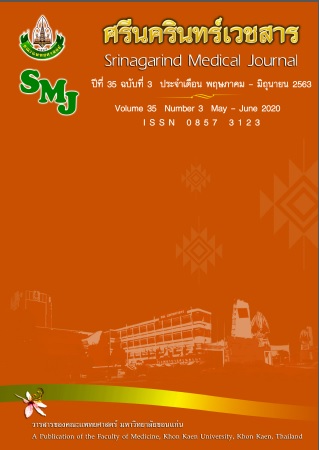The Effect of Foot Reflexology Program to Relieve Pain in Patients with Cancer
Keywords:
cancer pain; pain management; foot reflexologyAbstract
Background and Objectives: Pain in cancer is an important symptom of suffering that affects the overall health. The objective of this study was to study The effect of the foot reflexology program to reduce pain in cancer patients
Method: This was a quasi-experimental reseach. The studied subjects were 30 randomized sampling of cancer patients with pain at every stage of treatment in the special ward 6B, special nursing department. Srinagarind hospital Khon Kaen university. To use the method of massage according to the foot reflexology program to reduce pain in cancer patients developed by the researchers, 30 minutes each, 15 minutes on each side, consisting of a 4-minute basic leg massage, foot reflexology, basic points 26. 5-minute points and highlight 4 key points (3,15,16, 17) 1/2 minute each point, total 2 sessions, total 4 minutes and basic massage to relax muscles 2 minutes. Data were collected by means of concealing in one way. (single-blind technique) use descriptive statistics in analysis by means of frequency distribution, percentage, mean, standard deviation And use Paired - Samples T - Test to compare the differences between the pain scores before and after receiving the foot reflexology program to reduce pain in cancer patients.
Results: Most of the patients, 66.6%, had colon cancer. The mean score of pain before and after receiving the foot reflexology program for pain reduction was 4.47 and 1.90 points, respectively. With statistically significant differences (t = 22.455, sig <0.01)
Conclusion: Foot Reflexology Program can reduce pain in cancer patients. Which should be considered as an additional option in pain management And should massage with a massage specialist to maintain the effectiveness of the massage And prevent side effects from massage
References
2. กลุ่มงานเทคโนโลยีและสารสนเทศ สถาบันมะเร็งแห่งชาติ. ทะเบียนมะเร็งระดับโรงพยาบาล พ.ศ. 2556. กรุงเทพฯ: สถาบัน; 2558.
3. สถาพร ลีลานันทกิจ. การใช้ยากลุ่ม opioids ในการบำบัดความปวด. ใน: พงศ์ภารดี เจาฑะเกษตริน, บรรณาธิการ. บำบัดความปวด, เล่ม 2. พิมพ์ครั้งที่ 2. กรุงเทพฯ: คณะแพทยศาสตร์ศิริราชพยาบาล มหาวิทยาลัยมหิดล; 2547; 29-104.
4. Fitzpatrick JJ, Stevenson JS, editors. Annual review of nursing research, Vol. 11. 2ed ed. New York: Springer Pub; 1993.
5. อัมรา พานิช. การบำบัดอาการปวดผู้ป่วยมะเร็งในโรงพยาบาลสงขลานครินทร์. วารสารมหาวิทยาลัยนราธิวาสราชนครินทร์ 2535; 3: 2–5.
6. เกวลิน ยงยุทธ. ประสิทธิภาพของการใช้กิจกรรมการพยาบาลบำบัดทางเลือกเพื่อบรรเทาความปวดและลดความวิตกกังวลในผู้ป่วยมะเร็ง: การทบทวนงานวิจัยอย่างเป็นระบบ. วารสารการพยาบาลและสุขภาพ 2553; 4: 85–95.
7. กัญจนา ดีวิเศษ, บรรณาธิการ. คู่มืออบรมการนวดไทย. พิมพ์ครั้งที่ 4. นนทบุรี: โครงการพัฒนาตำรา กองทุนสนับสนุนกิจกรรม มูลนิธิการแพทย์แผนไทยพัฒนา; 2544.
8. Chapman S. Chronic pain syndromes in cancer survivors. Nurs Stand 2011; 25: 35 – 41.
9. กองการแพทย์ทางเลือก. กระทรวงสาธารณสุข.คู่มือการกดจุดสะท้อนฝ่าเท้า.พิมพ์ครั้งที่ 2. นนทบุรี: กระทรวงสาธารณสุข. 2562 ; 12-13.
10. อุไร ยอดแก้ว, วงจันทร์ เพชรพิเชฐเชียร, วิมลรัตน์ จงเจริญ. ผลของการนวดกดจุดสะท้อนที่ฝ่าเท้าต่อความรู้สึกปวดและความรู้สึกทุกข์ทรมาน จากความปวดในผู้ป่วยโรคมะเร็ง. วารสารมหาวิทยาลัยนราธิวาสราชนครินทร์ 2557; 6: 12–24.
11. ทัศนา บุญทอง. มโนมติการพยาบาลแบบองค์รวม. วารสารพยาบาล 2531; 38: 27–40.
12. ประสพชัย พสุนนท์. การกำหนดขนาดตัวอย่างตามแนวทาง Krejcie and Morgan (1970) ในการวิจัยเชิงปริมาณ. วารสารวิชาการศิลปศาสตร์ประยุกต์ กรกฎาคม - ธันวาคม 2557;112-117.
13. สุดารัตน์ ต่ายธานี. บรรณาธิการ. ตำราเรียนการนวดกดจุดสะท้อนฝ่าเท้า. พิมพ์ครั้งที่ 2. อุบลราชธานี.โรงเรียนสุดารัตน์การแพทย์แผนไทยอุบลราชธานี; 2547; 29-46.
14.Tiran D, Chummun H. The physiological basis of reflexology and its use as a potential diagnostic tool. Compl Ther Med 2005; 11: 58-64.
15. Jaloba A. Healing the sole. Nurs Stand 2011; 25: 18–9.
16. Samabub S ,Petpichetchian W, Kitrungrote L.Psychometric properties of pain intensity scales comparing among postoperative adult patients, elderly patients without, and with early cognitive impairment. Presentation Research at Songkhla University, Pattani Campus; 2009; 1-18.




